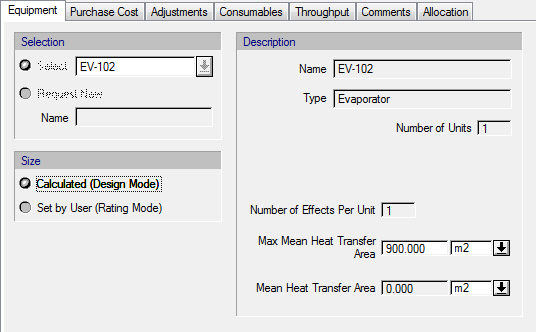

The following table shows the meaning of the variables appearing in this tab, as well as their default values and their generally acceptable range. Note that due to the manner by which the variables are used by the sizing and costing equations, the range of acceptable values may be further reduced.
|
Variable |
Default Value |
Range |
|
|
||
|
● Number of Effects Per Unit |
1 |
Positive |
|
◙ Mean Heat Transfer Area (m2) |
0.0 |
Positive |
|
○ Max Mean Heat Transfer Area (m2) |
900.0 |
Positive |
Symbol Key: ○ User-specified value (always input); ● Calculated value (always output); ◙ Sometimes input, sometimes output
In design mode, the software will size the unit based on the demand on mean heat transfer area by the multi-effect evaporation operation executed in the unit. If the mean heat transfer area exceeds the specification for the maximum mean heat transfer area then the software will assume multiple number of identical units (each with mean heat transfer area equally distributed) that are operated in parallel.
In rating mode, the mean heat transfer area of the unit and the number of units are provided by the user.
The equipment purchase cost is based on the mean heat transfer area and the number of effects. The built-in model is based on information available in D.E. Garrett’s Chemical Engineering Economics (New York: Van Nostrand Reinhold, 1989).
For more information on this equipment, see Multi-Effect Evaporator.
For information on the left-hand side variables and options, see Equipment Data Dialog: Equipment tab.